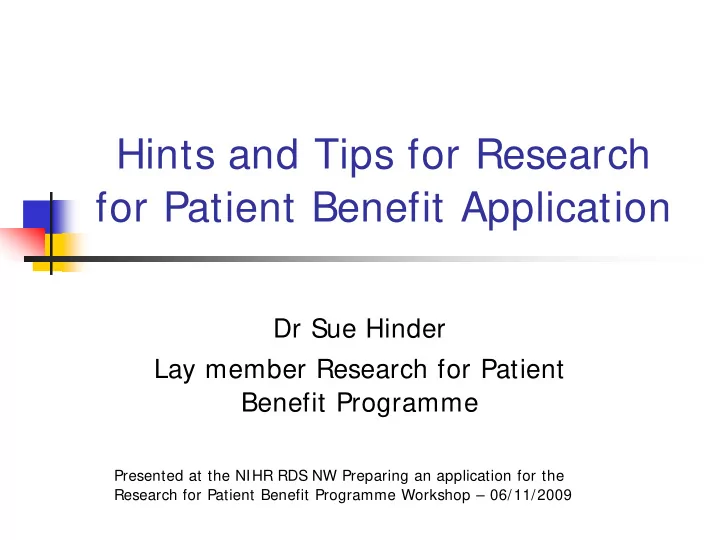

Hints and Tips for Research for Patient Benefit Application Dr Sue Hinder Lay member Research for Patient Benefit Programme Presented at the NIHR RDS NW Preparing an application for the Research for Patient Benefit Programme Workshop – 06/11/2009
First….. GET A STATI STI CI AN ! (For an RCT or pilot RCT)
Building a ‘dream team’ Service users and carers NHS organisations who will implement Clinicians – including frontline staff Academics – social scientist, research methodologist. Statistician Health economist
Actually, start here…. Applicat i t ions t h t hat t em erge from int e t eract i t ion w it h pat at ient s an and public ar are explicit ly w el elcom ed ed in the Guidance. Working with a service user group on problems arising out of their day to day engagement with NHS services can often help to keep the focus on the applied nature of the project and on the trajectory into patient benefit. (RfPB Guidance notes)
Patient and Public ‘Intelligence’ at all stages Going through your project like ‘Blackpool’ in a stick of rock Experts in their conditions and their communities Tacit knowledge Relevance Analysis and interpretation of findings Spreading the knowledge
Understanding of PPI Involvement in the DESIGN NOT getting service users and carer’s views in a study
Why PPI? Assurance that research is relevant Democratic accountability Making research value for money Information from experts in the condition Service user and carer ‘perspective’ Needed for IRAS ethics application
PPI and the Research Question Relevance – important v critical issues Easier implementation- importance of user, carer and staff views Small changes can have big effects – Complexity Theory & the coffee break The question you ask determines the answer
Reminder…. GET A STATI STI CI AN !
Clarity Make sure your proposal is clearly written You are writing for people outside your profession Committee members have up to 20 proposals to review plus the 3-7 peer reviews for each proposal Lack of clarity usually means not thought through
Scrutiny stage In scope for RfPB ? Patient Benefit in approx 5 years Probably not diagnostics Not ‘blue skies’ More suitable for another programme. HTA ? Pilots with a view to the main study OK Methods – fit for peer review? Is it being done elsewhere?
Peer reviewers Lay reviewer with experience of condition Lay reviewer with general view Researcher in the same field Researcher in similar field Widely differing views
Committee Clinical academics Social scientists 2/3 lay members Pre-reading Lead Assessors – reminder summaries Discussion -different opinions, even statisticians can disagree !
Common problems Forgot the statistician ! Lack of a ‘dream team’ Not referencing/discussing important research Too complex – too many assumptions Research methods Project management – is it realistic?
Costings £249,999 – suspicious ! Looks like the project may have been developed to fit the budget
Literature Reviews Acceptable as part of the proposal Updating of literature review What if the research question or research design changes as a result of the literature review?
How to do Patient and Public Involvement http://www.rds- nw.nihr.ac.uk/PI/how_to_guide.php Takes time and money
Develop a user group Multiple views Developing knowledge of research methods Developing working relationships Enthusiasts Involvement Portfolio
And… Self-help groups Individual service users from practice
Which users and carers? Very important not to ‘tick the box’ People with direct experience of the condition Carers with direct experience of the condition Make no assumptions Leaders of community groups – do they really know?
Patient and Public Involvement section Describe who has been involved and how Has the proposal developed from issues raised by service users or problems in practice Describe how they will be involved throughout the project Aim for 3 service users on steering group or advisory group Payment offered
Patient and Public Involvement section Lay members would like this moved to the front of the form to ‘nudge’ researchers towards considering PPI at the beginning.
Focus -start with the end in mind…. Will the results of this research make life easier for the service user or carer?
Questions
Group work The Diabetes Patient’s Forum have called for training for their partners or carers. They believe this will help to improve their self- management and lead to less hospital visits and ambulance call outs. They also believe it will improve their quality of life by helping them feel more secure in the knowledge that their partner or carer can cope if they are unwell.
Group work 30 mins discussion Develop the research proposal Brief notes in the RfPB template Feedback Discussion
Thank you…. Dr Sue Hinder RaFT Research and Consulting Lower Hall Downham Clitheroe Lancashire 01200 440912 susan.hinder@virgin,net
Recommend
More recommend